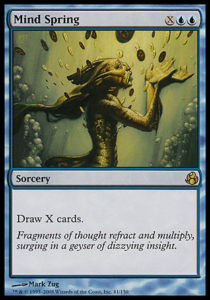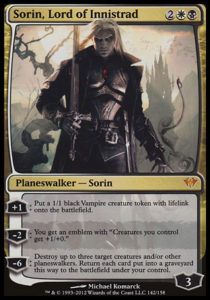Hello again, folks! Modern Masters comes out this week and the universe stands on edge. It’s the first all-reprint set since Tenth Edition came out in 2007 and yet for some it’s garnered more excitement that new expansions. The set promises valuable Modern staples in an exciting new Limited format that vaguely resembles cube draft—what’s not to love?
Sam Stoddard, developer for Magic: the Gathering, wrote a great article about the color combinations in Modern Masters limited. Every color pair will have a different mechanic/archetype available to it:
WU—Artifacts/Affinity
UB—Faeries
BR—Goblins
RG—Suspend/Storm
GW—Tokens/Thallids
BW—Rebels
UR—Splice onto Arcane
BG—Graveyard/Dredge
RW—Giants
GU—Ramp/Sunburst
Many of these archetypes are not particularly parasitic; sure, Amrou Scout makes your Bound in Silence better and Sporoloth Ancient and Sporesower Thallid ramp up Saproling production, both all of these cards are good enough on their own to make the cut in Limited decks. This is great! Rather than be forced to focus on what archetypes are open when drafting, you can focus on what colors are open. Accordingly, you may be rewarded with designer-intended interactions without having to dedicate yourself P1P1 to being the “tokens” or “rebels deck.” Of course, you can also take an early Mad Auntie or Esperzoa, cut an archetype hard, and have a sweet deck.
I compare this to triple Lorwyn draft, wherein you could be doomed to failure merely for choosing the wrong color pair. If you drafted green-blue (no tribe) or white-black (secondary treefolk), you wouldn’t be in a tribe, wouldn’t have as many inbuilt interactions, and would likely have a weak deck.
Modern Masters appears flexible enough to support all ten color combinations as well as parasitic archetypes (without forcing players into these archetypes). This is great…and reminiscent of arguably the greatest draft format ever.
Innistrad was an amazing Limited format. If you didn’t get a chance to draft it, I strongly encourage you to buy a box or get on Magic Online. Every color pair had an available archetype, was viable, and didn’t require parasitic interactions to be viable (though the skillful drafter could use these inbuilt archetypes to improve draft decks). Innistrad also oozed flavor and was the best top-down designed set ever, but that’s besides this point. Here’re all ten color pairs and their associated decks/archetypes:
WU—Spirits/flying creatures
UB—Zombies (though blue skaabs and black zombie tokens were often nonsynergistic, there were cards like Undead Alchemist and Ghoulraiser that rewarded the UB drafter)
BR—Vampires and BR control (grab all of the removal)
RG—Werewolves (an archetype that didn’t really work until Dark Ascension provided Wilf Hunger and Immerwolf)
GW—”Humans”/Travel Preparations (the arguably most powerful human interactions were in WB; GW was often two-drop aggro.dec and insanely powerful for it)
BW—Humans/crunchy human sacrifices (another archetype that became much better with Dark Ascension)
UR—Burning Vengeance/flashback
BG—I don’t recall there being any heavy theme in BG. Normally it’d be graveyard-interaction, but every color in Innistrad had graveyard interactions. Of course, black-green had a particularly important card that we’ll see soon.
RW—Tokens/aggro (a few red cards, notably Rally the Peasants directly aided tokens decks. Red-white was one of the less overt archetypes and combined both colors’ aggressive creatures with cards like Brimstone Volley.)
GU—Spider Spawning (the most parasitic and unbeatable archetype in the format. These decks always included black for the flashback on its namesake card, which makes BUG likely one archetype.)
Some archetypes were more parasitic than others (notably UR Burning Vengeance and GUB Spider Spawning), while others had fewer interactions (like RG Werewolves in Innistrad and BG without blue). This is good; if the format is full of parasitic archetypes, then drafting is just a matter of identifying which precise archetype is open. If the format is too modular, then it’s a matter of identifying which colors are open and making a “good stuff” deck (I discuss parasitism and modularity in a previous column). A combination of parasitic and modular archetypes is, to this writer, ideal; you reward good drafting habits (B.R.E.A.D. and identifying open colors) as well as reward keen-eyed drafters with parasitic interactions.
Modern Masters appears to embrace this—UR Splice onto Arcane and BG Dredge should be more parasitic than RW Giants and GU Ramp, but all colors have parasitic interactions as well as modular cards and mechanics. One could draft a sick WU Affinity deck or a sick WU skies deck with Errant Ephemeron and Sanctum Gargoyle. You could pair Avian Changeling with Blind-Spot Giant as intended or with blue faeries or black goblins. The dedicated Dampen Thought drafter can find arcane spells in every color (though red has the most with four, being tied with blue; white has one, black has two, and green has one).
I doubt that I’ll be able to draft all of these color combinations—Modern Masters will be both expensive and very limited in supply. However, I hope to get a fair deal of testing done for Grand Prix Las Vegas (which is less than three weeks away) both in paper and online. Until then, I can only wait with bated breath for Friday.
Zach B.
twitch.tv/ZennithGP



